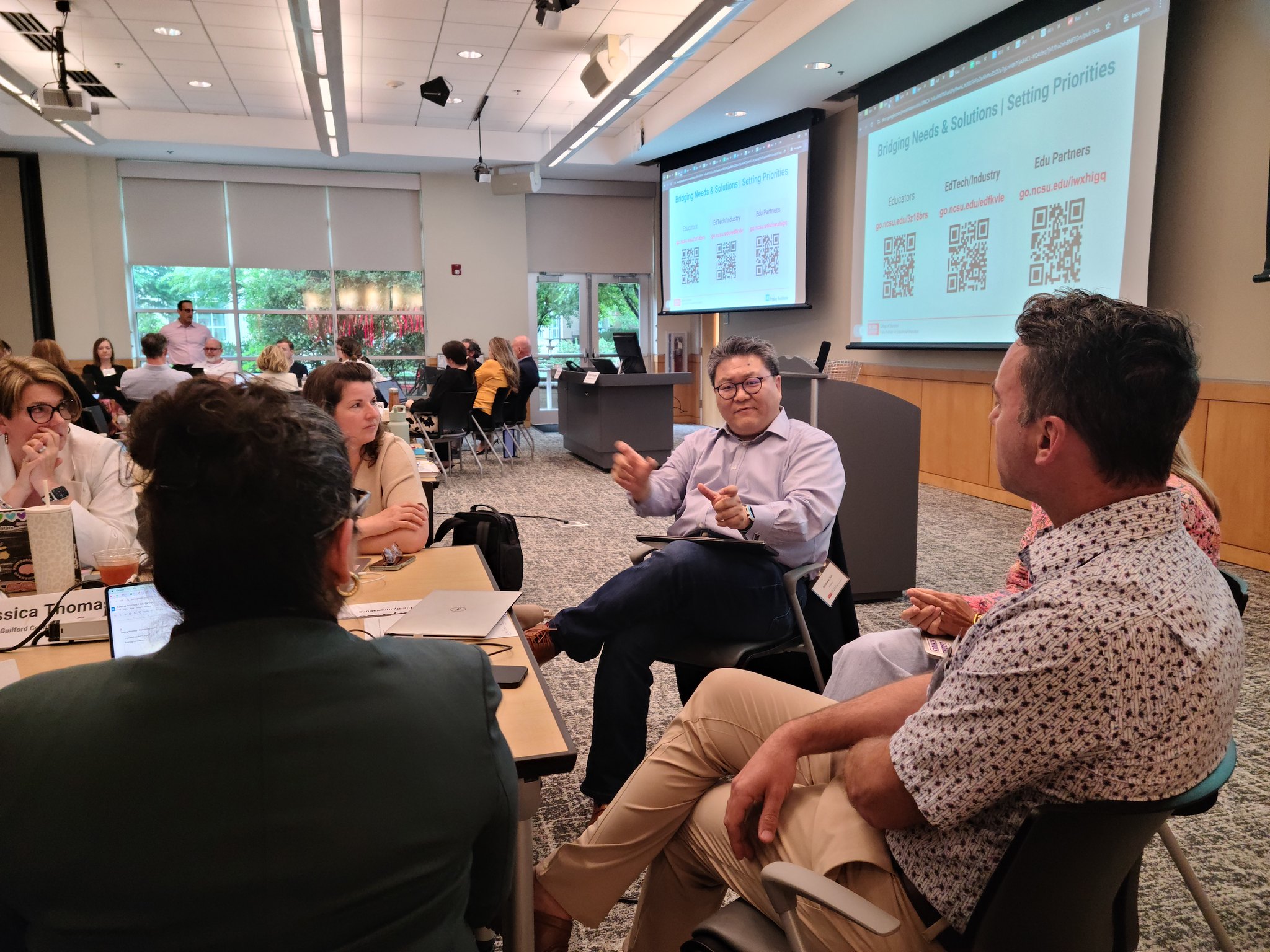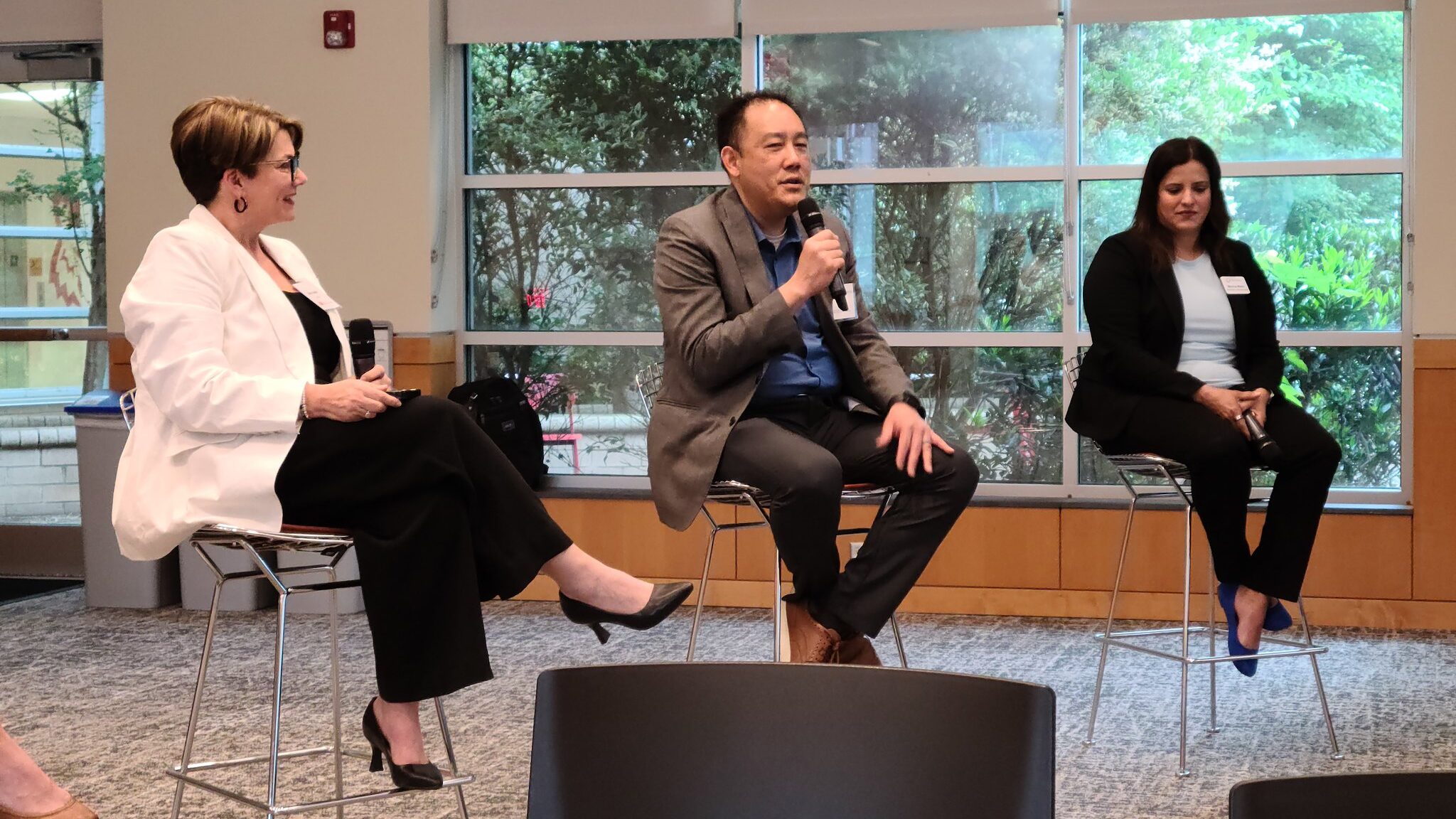Building Bridges Between Education and EdTech for K-12 AI Integration

In the Alamance-Burlington School System, many teachers aren’t worried that AI will replace them. They’re excited about learning how AI can save time and help them with logistics and administrative tasks.
“Currently, what I am experiencing is that many teachers are excited about discovering how AI can be used to create imaginative timesaving functions like lesson planning and organization and effective parent communications,” said Dennis Frye, executive director of technology in the Alamance-Burlington School System. “Done right, AI will reshape education in ways that deliver outsized benefits for teachers, students and for educational outcomes.”
But making decisions about which AI tools to adopt and how to implement them in schools and districts can be challenging. In May, educators met with education technology companies and education researchers at the Building Bridges Between School Districts and EdTech Symposium, hosted by the Friday Institute for Educational Innovation in partnership with Microsoft, ClassLink, Advanced Learning Partnerships and Merlyn Mind, to foster strong collaborations, address common challenges and leverage opportunities for AI tool integration in K-12 education.
“I have really been impressed in the extent to which we are solving this issue,” said Krista Glazewski, executive director of the Friday Institute and associate dean of translational research in the NC State College of Education. “The question that we all could be asking ourselves is, ‘How is what we’re doing bringing people together and not putting tech in the middle?’ We want the tech to be a facilitator and not a divider. I’m hoping that what we’re able to do is push and meet some of these priorities jointly so that we are in dialogue, discussion, conversation together to address some of these problems.”
During the symposium, conversations were held among featured panelists and participants about the landscape of AI in education and edtech, analysis and aspirations for AI in education and the frameworks needed to evaluate and innovate edtech tools.

The first panel of the day, “Insights and Best Practices from Education Leaders,” discussed the tools and instruments available to support edtech providers and school districts with AI implementation, including Digital Promise’s AI Literacy framework. As Pati Ruiz, senior director of edtech and emerging technologies at Digital Promise explained, AI literacy includes skills to use, understand and evaluate AI systems and tools, and these foundational skills are essential for AI literacy to relate to existing initiatives in education.
“Without the foundation of these domains, anything structural built on top is going to fall,” said Marlo Gaddis, former chief technology officer for the Wake County Public School System and a board member for the Consortium of School Networking (CoSN), of the key factors before implementing AI tools in districts as described in CoSN’s K-12 Generative AI Readiness Checklist. These factors include readiness in executive leadership, operations and data, technology, security, legality and risks.
There were many resources available to education leaders discussed during the panel to assess edtech tools and technologies, including 1EdTech’s Trusted Apps Accessibility Rubric and the AI Preparedness Checklist, which panelist Monica Watts, senior director of learning innovation at 1EdTech, says will help educators begin to have conversations with their vendor partners. She recommended not to stop asking questions and to stick to trusted applications for data privacy, accessibility, security and more. The AI Preparedness Checklist was created by 1EdTech’s Emerging Digital Pedagogies Innovation Leadership Network (ILN) to provide institutions with guiding prompts for establishing protocols, policies and best practices for using AI in teaching and learning.
Another recommendation from the panel was to create an AI incident response plan to ensure the school community’s needs are surveyed, curriculum standards are met and that there is human oversight for monitoring processes.
“Whether you have a policy in place, whether you have resources, whether you have a database of solutions, you have system requirements and then you have an AI response plan,” said Patrick Gittisriboongul, assistant superintendent of innovation at the Lynwood Unified School District in Lynwood, California. “I think that’s kind of the magic formula to really put together for school districts…The more time you spend on the process, the better your outcome is going to be.”
During table talks throughout the day, attendees discussed systems, practices and frameworks currently used in their districts, schools and classrooms; the strengths, opportunities, aspirations and results of AI integration; and priorities and action plans for their next steps.

Another big priority addressed for AI integration was the emphasis on building partnerships across the education, industry and research sectors; co-developing solutions; and creating communities of practice. Participants emphasized the importance of their partnerships with third party edtech vendors in developing curriculum to use AI with research-based, equitable practices. During the afternoon panel, “Safe and Ethical AI Integration in EdTech,” edtech vendors showed their approach to AI integration in classrooms and their willingness to learn about what educators need from them. Emma Braaten, director of digital learning at the Friday Institute, shared the importance of supporting equitable education practices, evaluating tools through an equity lens and supporting educators in understanding and evaluating edtech tools before implementation. This responsibility can be shouldered by educators and edtech providers alike.
“Talking about safe and responsible AI is easy,” said Kristen Huff, vice president of assessment and research at Curriculum Associates. “Developing accurate, safe and responsible AI that is also ethical in how it treats all students requires time, commitment, transparency and close collaboration with our educators across the country.”
This month, the United States Department of Education’s Office of Educational Technology released their own guide, “Designing for Education with Artificial Intelligence”, for edtech developers to foster conversation, next steps to promote robust development processes and resources that can provide additional support.
Finally, educators are looking for transparency about AI tools and their impacts and want to build trust with edtech partners through clarity and consistent communication, addressing some of the fears they might have associated with AI.
“A key area regarding AI in education that I’m interested in is making sure our teachers have a full understanding of how to use AI for themselves as a productivity tool to allow them opportunities to provide more personalized learning for students,” said Al McArthur, director of digital learning and libraries at Chapel-Hill Carrboro City Schools. “That will also allow them to make sure that they can use, potentially, some extra time that they get from AI assistance to have one-on-one conversations with students to delve deeper into small group work, allowing students the time to make sure that they get what they need just in time.”
- Categories:


